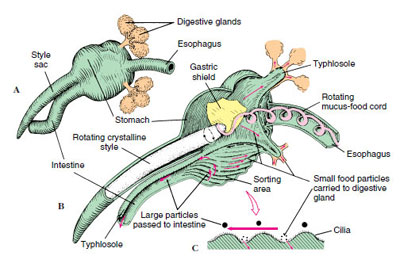
Eastern Oysters were once abundant in Barnegat Bay. Due to over harvesting and disease their numbers have been significantly reduced.
Eastern Oyster Environment and Habitat
 Oysters live in salty or brackish waters on all U.S. coasts, clustering on older shells, rock, piers, or any hard, submerged surface.
Oysters live in salty or brackish waters on all U.S. coasts, clustering on older shells, rock, piers, or any hard, submerged surface.
They fuse together as they grow, forming rock-like reefs that provide habitat for other marine animals and plants.
Benefits of an oyster reef habitat
Seafood – Oyster cultivation and harvest provide significant economic value to regional coastal communities.
Habitat for other species – The structure that oyster reefs create provide crevices that fish and crabs need to hide from predators.
Water quality – oysters filter water for food (algae) but also bring in all nearby suspended particles. The discharge is clean water and waste which settles to the bottom.
Storm protection – oyster reefs can protect underwater vegetation and waterfront communities from waves, floods, and tides.
 Juvenile oysters (also called spat) attach themselves (with a glue-like substance) to rocks, shell or other oysters.
Juvenile oysters (also called spat) attach themselves (with a glue-like substance) to rocks, shell or other oysters.
After time, this accumulation of oysters and shell forms a reef.
These reefs not only provide an environment for future generations of oysters but a habitat for many different species of animals.
Fish such as blennies and gobies, grass shrimp, snails, barnacles, mussels, flatworms and crabs to name a few.
The smaller animals in turn become food for larger animals such as flounder and weakfish. (everybody benefits)
The importance of eastern oysters continued when baymen began harvesting shellfish for sale and associated industries developed.
At the peak of the oyster industry, from 1870 to 1930, the Barnegat Bay-Cape May area produced 20 percent of all market oysters harvested in New Jersey.
By 1930 this figure declined to less than 10 percent. Oyster harvest declined for various reasons including overharvest, disease and changes to the bay’s environment
Oyster habitat was lost due increased salinity and sedimentation resulting from alteration of Beach Haven Inlet by the storm of 1919, and by the construction of the Point Pleasant Canal in 1925.
High salinity favored oyster predators and parasites and sedimentation smothered oysters. The effects of severe storms on the bay’s ecology gain even greater significance today in the aftermath of Hurricane Sandy.
Sediment
Sand, silt and clay are a natural part of the Bay, but contribute to the “muddy” bottom that is good clams, crabs and other shellfish it is detrimental to oysters that will suffocate if not attached to a hard surface.
Sediment buildup on the bay bottom after years of sand and soil runoff from erosion and construction has entered the bay with nowhere to go but to the bottom.
Decaying plant and animal matter also add to the sediment.
Disease
Two diseases both contributed to the decline of the oyster population not only in Barnegat Bay but along the entire eastern seaboard as well. They are MSX and Dermo.
MSX refers to a disease of oysters caused by the protozoan organism Haplosporidium
nelsoni. MSX (which stands for “multinucleated sphere X”)
Dermo disease was first identified as the cause of extensive oyster mortalities
More detailed information can be found on the Oyster Disease page
There is however, some good news.
As a result of Aquaculture more and more “Oyster Farmers” are making a living producing oysters for market and in turn help to make the bay cleaner.
Credits
